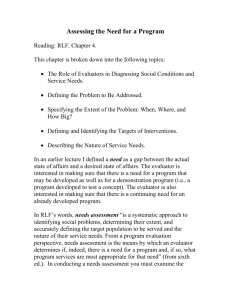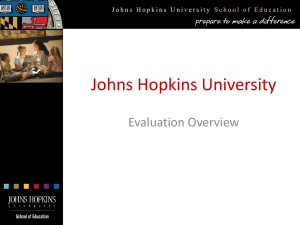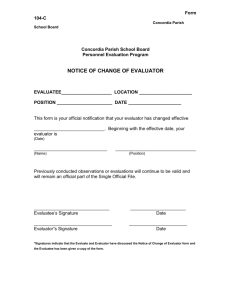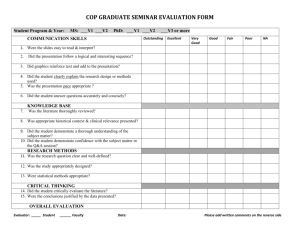Monitoring Program Process and Performance
advertisement
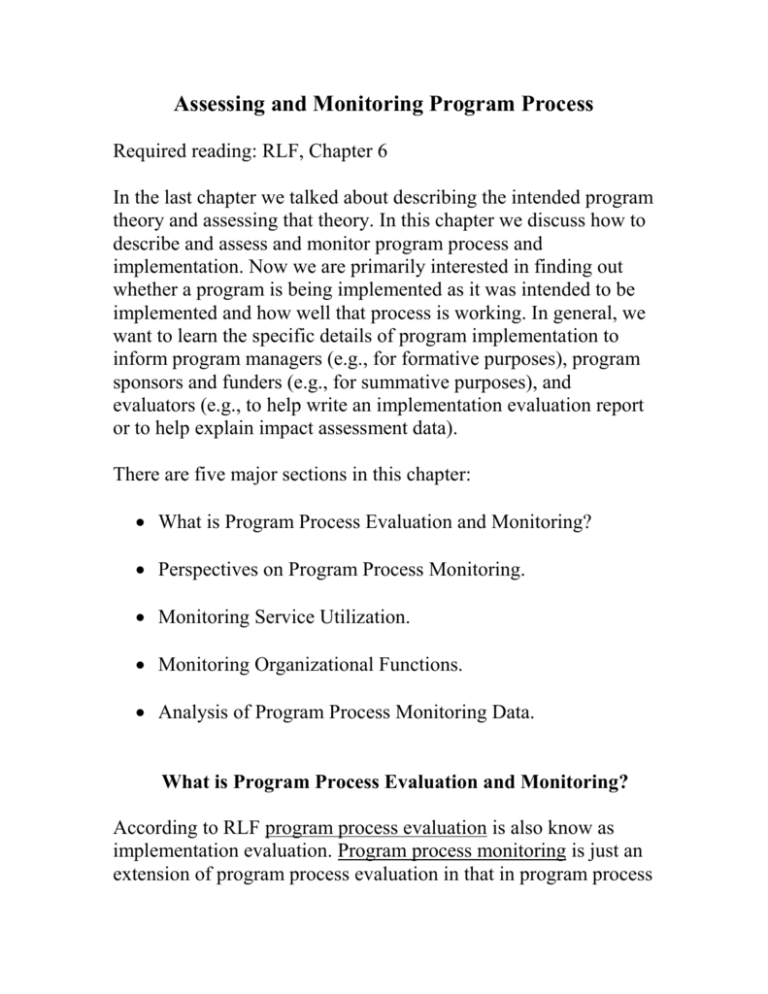
Assessing and Monitoring Program Process Required reading: RLF, Chapter 6 In the last chapter we talked about describing the intended program theory and assessing that theory. In this chapter we discuss how to describe and assess and monitor program process and implementation. Now we are primarily interested in finding out whether a program is being implemented as it was intended to be implemented and how well that process is working. In general, we want to learn the specific details of program implementation to inform program managers (e.g., for formative purposes), program sponsors and funders (e.g., for summative purposes), and evaluators (e.g., to help write an implementation evaluation report or to help explain impact assessment data). There are five major sections in this chapter: What is Program Process Evaluation and Monitoring? Perspectives on Program Process Monitoring. Monitoring Service Utilization. Monitoring Organizational Functions. Analysis of Program Process Monitoring Data. What is Program Process Evaluation and Monitoring? According to RLF program process evaluation is also know as implementation evaluation. Program process monitoring is just an extension of program process evaluation in that in program process monitoring the data are systematically collected repeatedly over time. The systematic documentation of aspects of program implementation that are indicative of whether the program is being delivered as promised and is functioning as intended, according to appropriate standards. In this chapter the focus is on monitoring program performance related to program process (process monitoring); in the next chapter we will focus on monitoring program outcomes (outcome monitoring). Thinking back to the last chapter which was on program theory (i.e., process theory and impact theory), the focus of this chapter is on program monitoring, which involves measuring and assessing the actual implementation of the process theory (including service utilization and program organization). On pages 171-172, RLF provide a nice list of questions to get you started on what you may want to consider examining as you conduct a program process evaluation and monitoring. Obviously many of these questions will not apply to some programs, you will need to tailor the questions to your particular program, and you will need to add additional questions that are needed in your particular context and circumstances. I will repeat the seventeenquestions here for your convenience: 1. How many persons are receiving services? 2. Are those receiving services the intended targets? 3. Are they receiving the proper amount, type, and quality of services? 4. Are there targets who are not receiving services or subgroups within the target population who are underrepresented among those receiving services? 5. Are members of the target population aware of the program? 6. Are necessary program functions being performed adequately? 7. Is staffing sufficient in numbers and competencies for the functions that must be performed? 8. Is the program well organized? Do staff work well with each other? 9. Does the program coordinate effectively with the other programs and agencies with which it must interact? 10. Are resources, facilities, and funding adequate to support important program functions? 11. Are resources used effectively and efficiently? 12. Is the program in compliance with requirements imposed by its governing board, funding agencies, and higher-level administration? 13. Is the program in compliance with applicable professional and legal standards? 14. Is performance at some program sites or locales significantly better or poorer than at others? 15. Are participants satisfied with their interactions with program personnel and procedures? 16. Are participants satisfied with the services they receive? 17. Do participants engage in appropriate follow-up behavior after service? As part of the RLF evaluation model, program monitoring also involves assessment or evaluation (please note that this also applies to the next chapter on outcome monitoring). Therefore, you will be applying the four steps in the logic of evaluation to the monitoring data (i.e., select dimensions of merit, set standards on those dimensions, collect performance data, and integrate the results into evaluative judgments). Here are four sources of standards that you may find useful: 1. Program theory – as discussed in the last chapter, program theory tells us what “should” happen, and the word “should” represents an evaluative concept (i.e., valuing). The process theory (service utilization plan and organizational plan) tells us what should take place during the operation of the program. Think of it like this: determining whether the appropriate activities occur or not occur is a basic standard or criterion issue. Typically these standards will be categorical; however, sometimes you can develop quantitative measures that represent the degree of “good” performance. 2. Administrative standards or objectives – these are the most commonly used standards. They are set by program administrators or other responsible parties (such as program sponsors). Administrative standards are usually quantitative and specific (e.g., 90% of the program entrants will complete the full program). Administrators usually rely on past experience, performance in similar programs, and requirements handed down by program sponsors as they make judgments about what levels are required for adequate or good performance. 3. Legal, ethical, and professional standards – Some programs will be required to meet certain legal requirements (e.g., how one approaches a child who is believed to have been abused by his or her parents). Ethical and professional standards may also suggest what level of certain behaviors are appropriate. For example, all persons testing positive on HIV screening test should be counseled and given appropriate medical treatment. 4. After-the-fact judgments – The standard here is set by the evaluator (and others participating in the evaluation) or program staff after examining program implementation. A professional judgment is made whether each result is good. In reality, this is how a lot of standard setting actually takes place. RLF point out that there are two common forms of program process evaluation: 1. Process or Implementation Evaluation. Here we use the term process evaluation in a narrow sense to refer to a evaluation of program implementation of the service utilization and organizational plans, but this evaluation is not regular or a continuing part of the data collection. It answers the question, “Is the program delivered as intended?” It provides a check on program process performance and provides formative information that can be used to further develop or improve a program. A process or implementation evaluation can be a stand alone evaluation; it also can be used to complement the impact evaluation (to help understand how and why impact did or did not occur). 2. Continuous Program Process Evaluation (i.e., monitoring) and Management Information Systems. This refers to the continuous (i.e., periodic) monitoring of program process. The data are usually computerized, and periodic reports are provided to program management and others needing the information. Some examples of what is monitored are delivery of services, billing, costs, diagnostic information, data on clients’ status, background data, testing data, prospective and retrospective evaluation by clients, and any additional information that is needed for routine operation of a program. Continuous information is useful because it is built into the data collection system and it provides repeated information that can provide information about trends and provide data that suggest when corrective action is needed. Perspectives on Program Monitoring There are three relatively distinct perspectives on program monitoring. 1. The evaluator’s perspective on monitoring. An external evaluator is typically called to conduct an impact assessment. However, to do this, implementation data are very important and useful in relating implementation to impact. Implementation data may allow a theory-driven rather than a black-box impact evaluation to be done. Implementation data can help the evaluator interpret negative or nil program results—if a program shows no impact then perhaps the program was not implemented correctly. Were the poor impact results due to implementation failure? Internal evaluators are often called upon to conduct process evaluation for the purposes of documenting what was done and also to collect data to be used for formative evaluation and program development. A nice example is given in Exhibit 6-A. 2. The perspective of groups primarily interested in monitoring data to be used for accountability. Program sponsors need accountability information to determine whether the program is operating as required and to make summative decisions. They will often use an external evaluator for this (i.e., to act as “their eyes and ears” or as their “watchdog”), although internal evaluators can also provide process or implementation information. The most commonly stated advantage of using an external evaluator rather than an internal evaluator is that the former is considered to be more objective because he or she is not part of the program or organization. Others interested in accountability monitoring data are political allies, program critics, and any other concerned parties. A nice example is given in Exhibit 6-B Perspectives on Program Process Monitoring Evaluator’s Perspective. Process monitoring information is very helpful in understanding, as mentioned earlier, impact assessment data. It helps to turn what would have been a black box into a clear box (i.e., it gives insight into what occurred, how the program was delivered). It can be used to determine whether poor impact is due to implementation failure. Accountability Perspective. Here the information is used by those who sponsor or fund the program. If you fund a program, it obviously is essential that the program be implemented at the level promised. As RLF point out, “No social program that receives outside funding, whether public or private, can expect to avoid scrutiny and escape demand for accountability.” Here is their definition (from p.200) of accountability: “The responsibility of program staff to provide evidence to stakeholders and sponsors that a program is effective and in conformity with its coverage, service, legal, and fiscal requirements.” Management Perspective. Managers are especially interested in process monitoring information for formative purposes, so that they can fine tune and make adjustments in how the program is being operated. If something is not being done that should be or if an implementation problem is occurring, they can take immediate action (this can even include making on-going adjustments or refinements in the program’s design). Managers are also interested in monitoring data so that they can provide the data to their superiors and program sponsors for accountability purposes. Monitoring Service Utilization Managers and sponsors are interested in service utilization data to make sure the correct people are participating in the program. Service monitoring involves identifying service utilization indicators and measuring performance on these indicators. If you examine a well developed service utilization plan you will easily come up with many service related questions needing answers. Here are a few possible questions to get you started: Do clients go through the sequence correctly? Where in the program sequence do some clients drop out? Who drops out? Why do they drop out? How do clients view the service delivery? What factors affect client demand for the program services? Do different client groups have different patterns of use? Are clients satisfied with program services? You can add many more questions to this list based on your particular program and your thinking about service utilization. Under the topic of service utilization, RLF also emphasize the importance of documenting program coverage (i.e., the extent to which a program reaches its intended target population). A bias in coverage might occur when subgroups of a target population participate differentially in a program. You will need to answer the program coverage question in any evaluation. Some potential problems that may be identified are overcoverage (i.e., some people being served are not in need of the service) and undercoverage (i.e., some people in need are being excluded from the program for one reason or another). Creaming (i.e., only serving the people who are the most likely to succeed) is one form of undercoverage. Undercoverage also results when potential clients lack demand for the program or when logistics don’t allow they to participate in the program. It generally is not difficult to obtain data about the people being served. Here are some ways: Program records. This will often suffice for those being served (if the correct records are routinely collected). Surveys. It can be difficult to obtain data on everyone in the target population because the people not being served may be hard to identify and hard to find. Therefore, a census or survey may be required to document the characteristics of all individuals and groups in the target population. Again, it is essential when examining coverage that you assess bias. That is, you need to look for differences between users (i.e., people who participate in the program) and those who are eligible but do not participate, as well as program dropouts. Monitoring Organizational Functions Managers and sponsors are interested in organizational functioning data to make sure that the program is managing its efforts well and is using its resources to accomplish its essential tasks. Organizational monitoring involves identifying organizational indicators and measuring organizational actions and performance using these indicators. If you examine a well developed organizational plan you will easily come up with many program organizational questions needing answers. Here are a few possible questions to get you started: Is the program operating according to the organizational plan? Is the program delivering the correct services? Are program resources being used appropriately? Is the organization doing a good job of delivering services? Are program staff currently well trained? Are program staff doing what they are supposed to be doing? Are the appropriate amount of program services being delivered? Do program staff have the resources they need to carry out their mission? Are the right people being served? Are the different program components organized well? Are the different program components being delivered properly? Is program staff morale generally high? Are burn-out and stress levels high among program staff? Are the structural and organizational arrangements organized and delivered in a way that facilitates participation in the program? You can add many more questions to this list based on your particular program and your thinking about monitoring the organizational functions. RLF identify three types of implementation failure that evaluators should look for during an implementation evaluation: 1. “Nonprograms” or incomplete interventions. That is, no intervention or not enough of it is being delivered to be effective. 2. The wrong intervention is being delivered. Perhaps program staff were confused or not well trained in how to correctly deliver the program. 3. An unstandardized intervention or an intervention that varies widely across sited is delivered. This sometimes occurs when program sites have great leeway in deciding what kind of services they want to deliver. Program services must be well specified and carried out, and the program must be easily accessible to the intended clients. Another important issue to consider is whether program support functions (e.g., fund raising, public relations, human resources, etc.) are in place and are likely to be maintained in the future. If these support functions are eliminated or they dissipate, implementation will likely fail. Hence, you should consider including indicators of program support activities. In general, there are at least three major ways you can use to collect monitoring data. 1. The evaluator collects observational data (based on the evaluator’s observations and on informants’ observations). 2. The evaluator collects and examines service records data. If a management information system is in operation, the evaluator can easily examine these data. 3. The evaluator collects data directly from program participants via interviews or questionnaires (i.e., conduct surveys). Analysis of Monitoring Data and Concluding the Evaluation According to RLF, the analysis of program monitoring data addresses several key issues. First, you must describe the project and assess program operation, using your implementation indicators. Second, if a program has multiple sites you will need to make comparisons between sites and identify whether some sites perform better than others, and if so then why? Third, you must compare program performance to the program theory and look conformity of the program to its theory and design, looking for and explaining any discrepancies. Finally, you must use the logic of evaluation, make evaluative judgments, and disseminate your findings so that they can be used!
